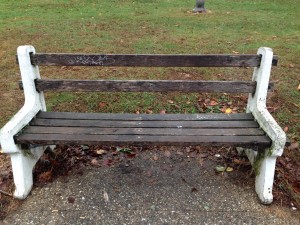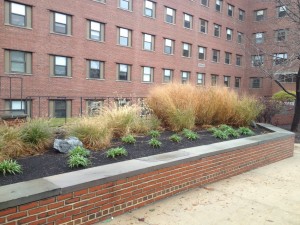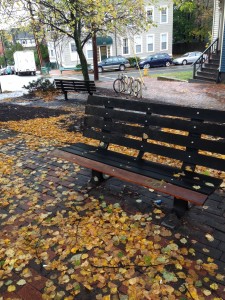This past Friday, Libby, Emma and I conduced a transect walk through the West End. We began our walk at Pine Street and State Street, walking towards the Western Promenade and making our way to Deering Oaks Park. We channeled William Whyte and took note of the public seating that was available in Portland. Overall, we noticed the lack of public seating along the streets and also the lack of maintenance of existing public seating. Both the Western Promenade and Deering Oaks Park could drastically be improved with additional public seating available – something Portland needs to focus on even before they expand the public space throughout the city.
As we began our transect walk through residential neighborhoods with brick sidewalks, it seems as though it would be a perfect place to sit down and relax. As one of the wealthiest parts of the city, I was amazed at the lack of public seating that was available here. We came across a tree stump where a tree had presumably been cut down recently, and talked about the potential that this stump had to create public seating. If trees have to be cut down, why not cut the stump at a height that is conducive to a seat? This is an easy way to incorporate local artists who can help design and carve tree stumps to create public seating, which possible could be lacquered for future use.
We also observed low stone pillars (43o39’02.15″N; 70o16’09.10″W) which could have easily been lengthened to create seating. This idea was definitely inspired by William Whyte – why create stone pillars with no purpose? They might as well double as a seat.
In the western promenade, there was a less than impressive amount of public seating, which discourages the use of this public space. We saw 6 benches throughout the promenade, none of which were nicely maintained or well-designed. These benches were run-down and in drastic need of improvement to even begin to look inviting to the public. All of the benches ran along the side-walk, which was also in need of improvement, but were too spaced out for practical purposes. It would be beneficial for benches to be placed in the green space to encourage use of the grass that is clearly well-maintained by the city. The views from sitting on the current benches were also not that pretty, they might as well be facing each other and looking towards the residential streets. (Promenade benches: 43o38’58.52″N; 70o16’34.65″W, 43o38’57.33″N; 70o16’34.62″W, 43o38’56.53″N; 70o16’34.73″W, 43o38’54.50″N; 70o16’34.15″W, 43o39’04.52″N; 70o16’34.98″W).
As we ventured away from the promenade and north towards the medical center, we noticed some blue round benches outside the center and near a bus stop. These seem like they would be highly utilized benches for the amount of traffic that comes through this area, however the seats were bright-blue metal and rusted, which also did not look very inviting. The positioning of them were closed off from the street view which did not seem to be the best design since you would have to seek them out opposed to stumble upon them. (43o39’07.83″N; 70o16’31.52″W)
The first usable public seating we saw was a stone wall outside of the medical center and near the bus stop, which seemed an ideal height. However, the lack of street lights in this area made us realize that they would only be an ideal seating place during daylight hours. (43o39’08.62″N; 70o16’29.70″W)
There was a similar stonewall across the street outside the parking lot, however there was a wrought iron fence positioned on top of the stone wall, which made seating impossible.
There were three benches that we saw at the intersection of Congress Street and Deering Ave, which all seemed to be in better condition than the benches in the Western Promenade. There were two benches next to each other but separated by a trash can, which does not make for a logical design(43o39’14.78″N; 70o16’21.44″W and 43o39’14.44″N; 70o16’21.02″W.) The third bench was isolated and facing away from the others (43o39’15.00″N; 70o16’21.27″W.) Although a nice place to have public seating, they did not make for conducive conversation setting.
Deering Oaks Park was the best public area that we encountered during our transect walk, although still in need of improvement. We saw 7 benches here, mostly located along the sidewalk, which were in better condition than the ones in the Western Promenade and also in better condition. Throughout all of the green space there were no park benches which could easily make the grassy area more conducive to public activity. We noticed one picnic table although it seemed isolated and random, but there is also potential to improve that area of the park. The lighting situation as not consistent either – some lamp posts were antique looking and pretty while others were more industrial and ugly. Lighting is a huge factor in the range of uses of the park and something that has to be improved. There also are no paths that run along the pond or any benches that look at the water – one of the more inviting and unique aspects of the park. This public space has the most potential for increasing activity – and we can start by improving public seating. (Bench 1: 43o39’25.03″N; 70o16’20.17″W, Bench 2: 43o39’25.32″N; 70o16’19.84″W, Bench 3: 43o39’26.10″N; 70o16’15.64″W, Bench 4: 43o39’26.22″N; 70o16’14.57″W, Bench 5: 43p39’26.48″N; 70o16’12.78″W, Bench 6:43o39’26.84″N; 70o16’11.52″W, Bench 7: 43o39’27.22″N; 70o16’10.67″W)











I really like the tree stump as seating idea, but now after looking at the photo for a second time, I noticed the location of the stump in respect to the street. Would people want to sit that close to cars passing by? This question sparked a train of thought concerning seating along streets and where exactly it would be placed. We saw very little formal seating facilities on our walk through the West End and it makes me wonder if there is space to accommodate benches, etc. I would be interested in surveying the local residents to see how many people would like to see more seating, where they would like it, and in what form. Perhaps there is a significant number of older folks who just need a spot to rest and it does not matter how close they are to the road. Or, perhaps there are lots of families and parents would like a more isolated seating area to read a book while their infant naps in the stroller. The public’s input is critical for designing and locating seating that best meets their needs.
Jackie,
One thing I wonder about Portland is to know why people do not fully utilize its public space and seating. I think a survey, or even just continued observation, would help city planners to know if the problem was based in location, aesthetic, comfort, or some other quality. It seems like the benches you found were in general placed in locations where they did not actually serve an acute purpose. We used QGIS to find overlap between subway stops, high populations of women, and low coffee shop density; I think the same strategy would be helpful in determining where public seating in Portland will be most useful. It seems like more observation is necessary first—know understand who the audience for public seating is, where they exist, and what kind of seating they would be drawn to.
Eva
I think your focus on lighting is important. No matter how inviting a public space is, a lack of lighting and night will make it feel unsafe to many visitors. This is particularly pertinent as Maine gets dark early into the evening. You were right to pair the importance of seating and lighting together as fundamental features in the usability of public space.
I agree with Eva that it would be interesting to use QGIS to map locations that are particularly in need of benches. We definitely saw the arbitrary nature in which they were placed during our walk. This could also include Emma’s comment about taking the primary demand for seating into consideration.
Whoever yields the power to purchase and place seating in Portland can influence where people dwell, and therefore what they face, see, and encounter. How about putting tables and chairs at Monument Square? There is a bench wrapping around the base of the statue but that shape is minimally conducive to starting conversation.
With the idea for intersection between public art and seating, have you seen the seating in the Bowdoin art museum? The shape of their benches are fantastic. I think I am only thinking of one bench and that is the one you immediately see upon entering the museum — the curvy wooden one. What a conversation starter. So maybe you could consider the shape of seating, too, and how that influences how people sit together.